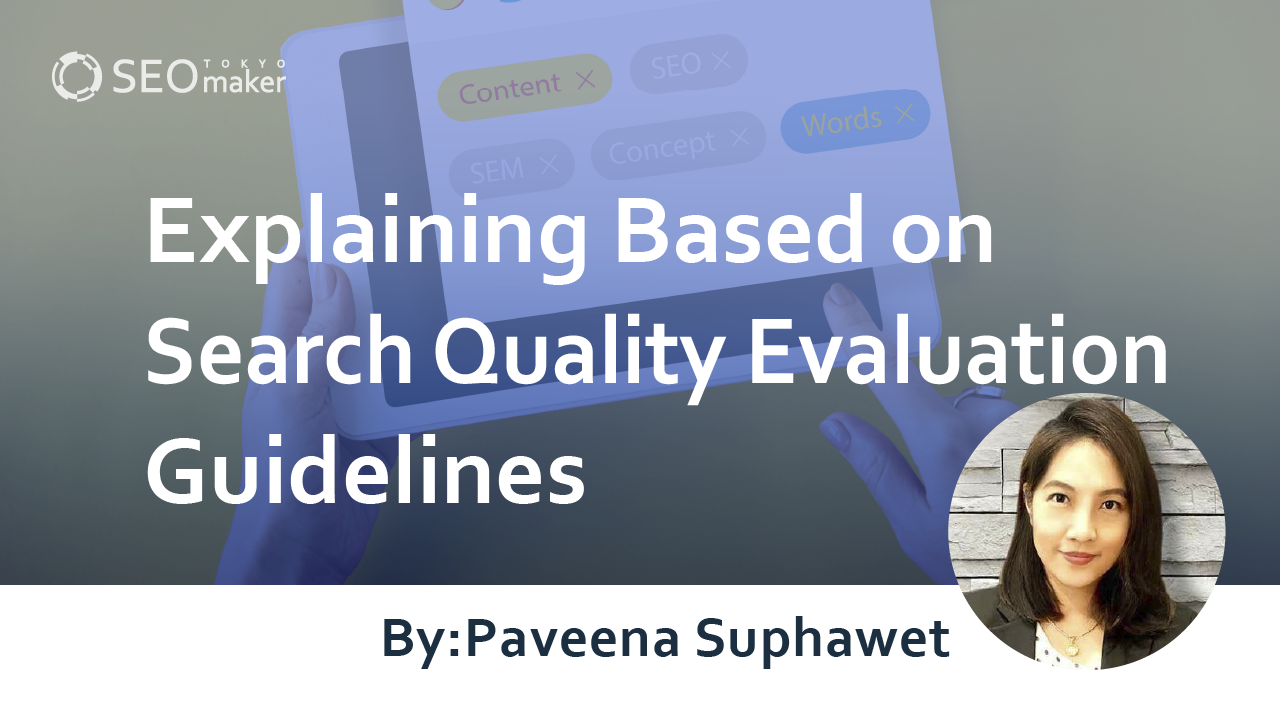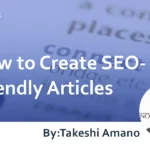Explaining Based on Search Quality Evaluation Guidelines
contents

Despite setting up a website, many express frustrations over not seeing an increase in traffic. While there are numerous ways to boost traffic, consider focusing on search engine-derived traffic.
To achieve a higher ranking on Google’s search engine results, SEO techniques are utilized. A critical aspect of SEO is the concept of Page Quality (PQ).
This article will discuss Page Quality, providing an easy-to-understand explanation based on the Search Quality Evaluation Guidelines, as detailed by Tokyo SEO Maker, an SEO specialist media.
What is Page Quality?
Page Quality (PQ) evaluates how well a web page fulfills its intended purpose.
For website managers, enhancing Page Quality is crucial for SEO considerations. Therefore, they should focus on improving the quality of their content and overall site to meet the page’s objectives.
Related Article: What is SEO?
Page Quality is defined within the Search Quality Evaluation Guidelines, which include;
- An overview of Page Quality assessment
- Understanding websites and web pages
- Criteria for Page Quality evaluation
- Descriptions of lowest quality pages
- Descriptions of low quality pages
- Descriptions of medium quality pages
- Descriptions of high quality pages
- Descriptions of highest quality pages
Factors Determining Page Quality Assessment
According to the Search Quality Evaluation Guidelines, the assessment of Page Quality is determined by the following factors.
- The presence of a page purpose
- Web page safety
- Whether the page is related to YMYL (Your Money Your Life) topics
- Appropriateness of the title tag
- Suitability of advertisements or side content
- Availability of information about the website and content creators
- Quality of the main content
- Reputation of the website and content creators
- Trustworthiness of the web page (E-E-A-T)
The Presence of a Page Purpose
The purpose of a web page is to satisfy the search user. However, what satisfies a search user varies depending on the theme or genre of the web page. This factor assesses whether the page has a defined purpose.
Web Page Safety.
Web pages should be safe for users to navigate. Pages that compromise safety and potentially harm users receive the lowest quality rating.
Page Theme and YMYL Area.
The page theme is used as a criterion for evaluating Page Quality. Furthermore, if the page theme falls within the YMYL (Your Money or Your Life) area, the reliability of the information disseminated within the page will be closely scrutinized.
Related Article: What is YMYL?
Appropriateness of Advertisements and Side Content
Typically, visitors to a web page acquire information from the main content area. However, there are cases where advertisements or side content outside the main content area may hinder the use of the main content, causing inconvenience to site visitors.
The issue here is not the presence or absence of advertisements or side content. Each of these elements is necessary for website operation, and as long as they serve their appropriate roles, they are deemed acceptable. The concern lies in whether advertisements or side content are obstructing the use of the main content.
Availability of Website and Content Creator Information
Information about the website and content creators is treated as a factor that supports the credibility of the page. Here, the evaluation checks whether the website provides information about the content creators.
Quality of Main Content
Firstly, the term “Main Contents” (MC) refers to the core part of a web page. Generally, creating and posting a web page entails preparing the main content. For instance, in the case of articles on Tokyo SEO Maker (this site), the portion highlighted in the image below represents the main content.
The role of the main content is to contribute to achieving the page’s objectives and providing a high-quality experience for search users. Therefore, high quality is required. According to the Search Quality Evaluation Guidelines, factors determining the quality of main content include;
- Effort expended
- Originality
- Talent and skills
Furthermore, when dealing with themes related to YMYL (Your Money or Your Life), ensuring the accuracy of information, such as by obtaining expert supervision, is required.
Reputation of Website and Content Creators
The reputation of the website and content creators significantly influences the credibility of the web page. This is a crucial element related to E-E-A-T.
Trustworthiness of Web Page (E-E-A-T).
E-E-A-T is a criterion proposed in the Search Quality Evaluation Guidelines, serving as an evaluation indicator for web pages in the Google search engine.
Related Article: What is E-E-A-T?
E-E-A-T stands for Experience, Expertise, Authoritativeness, and Trustworthiness.
E-E-A-T is utilized as a metric to gauge the accuracy of information disseminated by websites. It’s incorporated into search engines with the aim of providing valuable information to search users. In essence, websites with low E-E-A-T ratings may find it challenging to rank higher in search results.
Page Quality Evaluation Criteria
Cited from the Search Quality Evaluator Guidelines:
The evaluation of Page Quality is structured into five levels, with each level categorized based on the quality of the webpage.
Evaluation Translation
- Highest: Highest quality pages
- High: High quality pages
- Medium: Medium quality pages
- Low: Low quality pages
- Lowest: Lowest quality pages
Highest
The term “Highest” translates to ” Highest quality pages” and is defined as follows
“Highest quality pages serve a beneficial purpose and achieve that purpose very well. The distinction between High and Highest is based on the quality of MC, the reputation of the website and content creator, and/or E-E-A-T. “
Quote: Search Quality Evaluator Guidelines
In essence, “Highest” represents an evaluation of web pages that not only fulfill their intended purpose but also surpass those rated as “High.” The differentiation between “Highest” and “High” appears to be based on the quality of the main content, the reputation of the website and content creators, and E-E-A-T.
Therefore, anything classified as ‘Highest’ needs to possess the following elements as prerequisites.
- Presence or absence of page purpose
- Safety of the webpage
- Page theme and whether it falls within YMYL (Your Money or Your Life) areas
- Appropriateness of title tags
- Suitability of advertisements and side content roles
- Presence or absence of website and content creator information
Furthermore, we’ll assess page quality from the following perspectives.
- Quality of the main content
- Reputation of the website and content creators
- Trustworthiness of the webpage (E-A-T)
High
‘High’ is translated as ‘ High quality pages,’ and it’s defined as follows
“High quality pages serve a beneficial purpose and achieve that purpose well. High quality pages exist for almost any beneficial purpose you can imagine, from providing information to selling products to making people laugh to artistic expression. “
Cited from the Search Quality Evaluator Guidelines
High represents an evaluation of web pages that are fulfilling their intended goals. In High-quality web pages, whether they provide information, sell products, offer unique content, or serve various purposes, they effectively achieve their page objectives.
High-quality web pages, like Highest, also encompass the following elements.
- Presence or absence of page purpose
- Safety of the webpage
- Page theme and whether it falls within YMYL (Your Money or Your Life) areas
- Appropriateness of title tags
- Suitability of advertisements and side content roles
- Presence or absence of website and content creator information
Furthermore, they excel in the following aspects.
- Quality of the main content
- Reputation of the website and content creators
- Trustworthiness of the webpage (E-E-A-T)
Medium
‘Medium’ is translated as ‘ Medium quality pages,’ and it’s defined as follows
“Medium pages have a beneficial purpose and achieve their purpose. There is nothing wrong with Medium quality pages. Expect to encounter many Medium quality pages in PQ rating tasks. “
Cited from the Search Quality Evaluator Guidelines
Medium represents an evaluation of web pages that are capable of achieving their intended goals. These pages typically don’t have significant issues, and it’s predicted that the majority of web pages fall into this category.
Medium-quality web pages, like Highest and High, also possess the following elements
- Presence or absence of page purpose
- Safety of the webpage
- Page theme and whether it falls within YMYL (Your Money or Your Life) areas
- Appropriateness of title tags
- Suitability of advertisements and side content roles
- Presence or absence of website and content creator information
Furthermore, when assessing page quality, no issues are found in the following aspects
- Quality of the main content
- Reputation of the website and content creators
- Trustworthiness of the webpage (E-E-A-T)
Low
‘Low’ is translated as ‘Low quality pages’ and it’s defined as follows
“Low quality pages do not achieve their purpose well because they are lacking in an important dimension or have a problematic aspect. Low-quality pages do not meet the standards for Lowest but may have similar though milder undesirable characteristics. “
Cited from the Search Quality Evaluator Guidelines
Low refers to web pages that are unable to achieve their purpose due to some issue. However, they don’t have as serious issues as the Lowest category.
Low quality web pages face challenges in the following three elements.
- Presence or absence of page purpose
- Safety of the webpage
- Page theme and whether it falls within YMYL (Your Money or Your Life) areas
Considering this, the following elements need to be thoroughly examined.
- Quality of the main content
- Appropriateness of title tags
- Suitability of advertisements and side content roles
- Presence or absence of website and content creator information
- Reputation of the website and content creators
- Trustworthiness of the webpage (E-E-A-T)
Lowest
‘Lowest’ is translated as ‘Lowest quality pages’ and it’s defined as follows
“Lowest quality pages are untrustworthy, deceptive, harmful to people or society, or have other highly undesirable characteristics. The considerations for Lowest quality include quality of the MC, reputation, E-E-A-T, etc., but there are special checks you will need to complete first. “
Cited from the Search Quality Evaluator Guidelines
Lowest refers to web pages with critical issues such as credibility and harmfulness.
Lowest-quality web pages face critical problems in the following three elements
- Presence or absence of page purpose
- Safety of the webpage
- Page theme and whether it falls within YMYL (Your Money or Your Life) areas
Furthermore, please reassess the following elements
- Quality of the main content
- Appropriateness of title tags
- Suitability of advertisements and side content roles
- Presence or absence of website and content creator information
- Reputation of the website and content creators
- Trustworthiness of the webpage (E-E-A-T)
Actions to Improve Page Quality Evaluation
To improve Page Quality evaluation, consider the following.
- Understand the purpose of the webpage
- Ensure the safety of the webpage
- Consider E-E-A-T
- Consider YMYL
- Scrutinize the information provided
- Use appropriate page titles
- Include information about the content creator and enhance their reputation
- Enhance the quality of the main content
- Optimize the placement of advertisements and side content
Understanding the Purpose of the Web Page
Typically, the purpose of a web page is influenced by the nature of the page. For example, let’s consider a news article web page. In this case, the web page serves the following roles
- Quickly disseminating news to the general public
- Explaining the content of the news to encourage deep understanding
The following points are crucial in this context.
- Speed of information delivery
- Accuracy of information
- Breadth and depth of knowledge
- Communication skills
By setting the page’s purpose, it becomes possible to identify the necessary elements required to create the web page. When these elements become apparent, it also becomes clear what needs to be done to create the web page effectively.
Ensuring the Safety of the Web Page
If a web page lacks safety measures, visitors to the site may be at risk of harm. Especially on sites with payment functions or content where personal information is entered, visitors may suffer significant harm. Unsafe websites are ones that visitors would prefer to avoid.
For example, one technique to enhance website security is SSL encryption. This encrypts the data exchanged on the site, helping to prevent risks such as hacking or tampering with the site.
Related article: What is SSL Encryption?
These efforts to ensure safety are an absolutely essential prerequisite for building a website.
Considering E-A-T
By adhering to E-E-A-T, your website can support the accuracy of the information it provides to site visitors and Google search engines.
Specific measures include;
- Citing information from highly reputable websites and clearly indicating the source
- Publishing information about the website creator
- Including the credentials of supervisors or authors beneath web page articles
- Obtaining backlinks from websites with high relevance and authority
Related Article: What is E-E-A-T?
Considering YMYL
When websites or pages delve into YMYL topics, they are strongly expected by Google search engines to demonstrate reliability. YMYL refers to topics that may contain crucial life information, such as;
- News that threatens lives
- Matters of race or religion
- Prescription drug sales or reviews
- Medical diagnosis or post-treatment advice
- Investment advice
Related Article: What is YMYL?
These topics generally shouldn’t be handled by amateurs. However, if you’re an expert in any of these areas, be sure to thoroughly reflect E-E-A-T on your site.
Creating Appropriate Page Titles
Assigning suitable titles to pages enhances user convenience and plays a crucial role in SEO. Therefore, ensure your titles are aptly chosen.
An appropriate title essentially summarizes the content of the page.
Related Article: How to Create Titles
Include Information about Content Creators to Enhance Their Reputation
If you’re implementing E-E-A-T measures, you should already be including information about the content creators. However, if you haven’t done so yet, it’s advisable to take action promptly.
Furthermore, consistently creating high-quality content will also contribute to boosting the reputation of both the website and the authors themselves.
Enhance the Quality of Main Content
Low-quality main content implies low-value content. Since low-value content lacks demand, it’s essential to upgrade the quality of the main content.
Specifically, consider the following points when revising.
- Scrutinize the themes you address
- Ensure the accuracy of the information you disseminate
- Establish an appropriate page structure
- Craft text that is grammatically correct and tailored to the target audience
- Incorporate clear diagrams or tables
Optimize the Placement of Ads and Side Content
When integrating ads and side content into web pages, there’s a concern that it may disrupt the layout. Particularly, if it obstructs the use of main content or leads to issues such as excessive advertisement exposure hindering scrolling, prompt improvements are necessary.
- Overlapping with main content
- Excessive advertisement exposure on the view makes scrolling difficult
- Large data size causing delays in page loading speed
Common Questions about Page Quality
Here are some frequently asked questions and answers about Page Quality.
Q: What does Page Quality mean?
A: It’s an indicator of how well a page achieves its purpose.
Every web page has its own purpose. The more a page fulfills its purpose, the higher it will be rated by Google search engine.
Q: What is another term for Page Quality?
A: Page Quality is the direct translation.
Q: What is PQ an abbreviation for?
A: It stands for Page Quality.
Q: What does MC stand for?
A: MC is an abbreviation for Main Contents.
Q: What does SC stand for?
A: SC stands for Side Contents.
Q: What is the relationship between Page Quality and Needs Met?
A: To enhance Needs Met evaluation, it’s necessary to improve Page Quality.
Needs Met evaluates whether search results are useful to users. Websites with high Needs Met ratings are ranked higher, indicating high page quality.
To achieve a high rating in Needs Met, it’s essential to enhance page quality.
Related Article: What is Needs Met?
Summary
By improving Page Quality, SEO consultants can achieve better SEO results. Various factors determine the evaluation of Page Quality. Start by understanding each factor, apply them to your own website, and identify any issues. Then, solve these issues one by one to gradually develop a strong website for SEO.










![What is a Description? Explaining the Meaning, Writing Style, and Changing Word Count – [2023 Edition]](https://www.switchitmaker2.com/en/wp-content/uploads/2024/09/what-is-description.webp)










